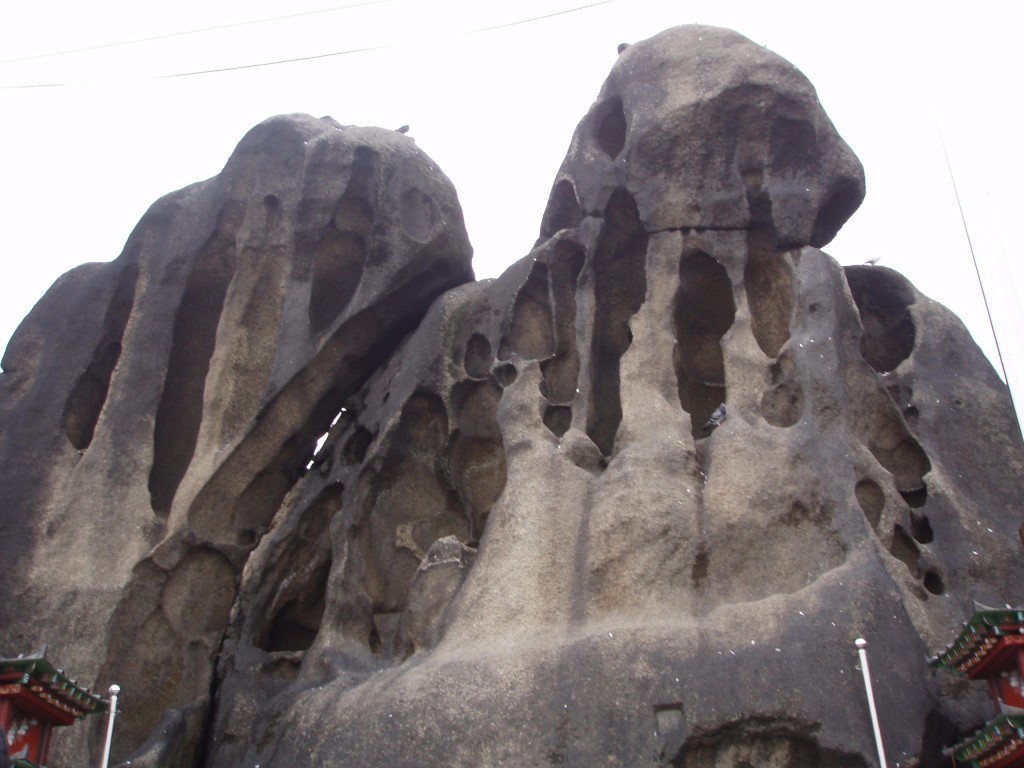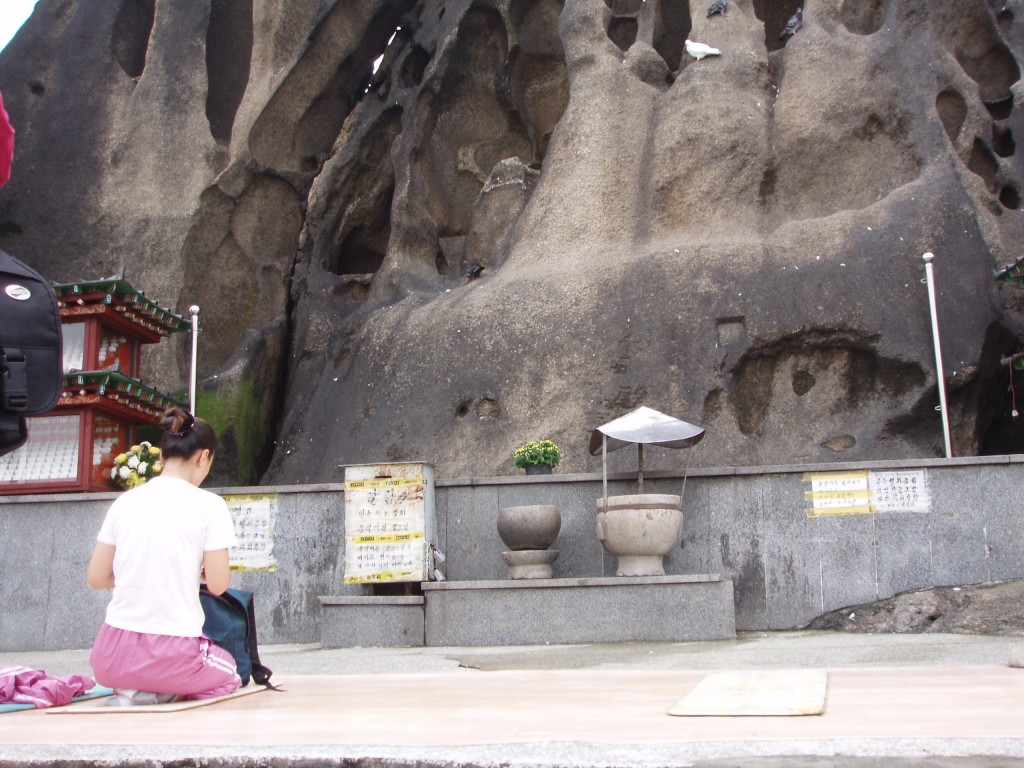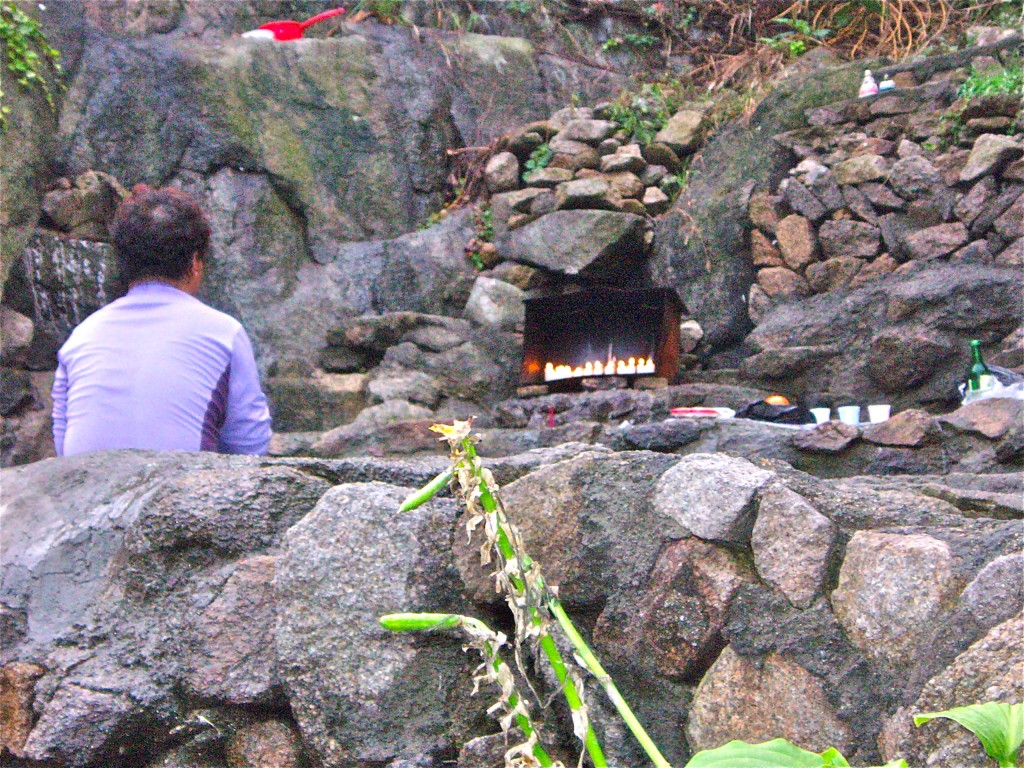
Seonbawi rock at Seoul, ghostly guardian over the city below
‘Actually not many Koreans know much about the shamanic tradition. It’s strange,’ scholar David Mason told me. ‘It’s as if they were ashamed of it. Few Koreans could face their past until the 1980s because it was all too painful. All that devastation. All the heritage wiped out. All the shame. It’s only recently that they want to look back and claim their past. But if you look around, there really isn’t that much. In Seoul there are the Royal Palaces, the City Gates, the Insadong craft street. That’s about it. So it’s strange they don’t embrace the shamanist heritage more fully. Until recently they were ashamed of it as primitive, and after the war they even tried to stamp it out as superstition. But you’re going to see how much a part it is of a living tradition.’
We were on our way to Mt Inwang, a shamanic hill with sixteen brightly-coloured Buddhist temples, garish by Japanese standards, which had once stood astride the old road to China. Inside were paintings of Sanshin, an old man with a beard, invariably accompanied by a tiger, who acted as protective deity to Buddhist temples.
On the hill stood the national shaman shrine, Guksadang. The main feature was an old Spirit Tree, spanning the three worlds, in front of which were offerings of alcohol. It was decorated in cloth strips of symbolic colours, the dominant being blue to signify the source of the cosmic order. (It is why the Korean president occupies a Blue House rather than a White House.)
For a national shrine it was unprepossessing, but Korean shamanism had never been institutionalised like Shinto and its structures were makeshift and homemade. There was no official form of worship, no set liturgy, and shaman practices were conducted in homes or outdoors. The closest it had come to organised religion was in its alliance with Buddhism.
Beyond the temples lay the rocky crag of Seon-bawi, one of the most worshipped rocks in the world. From the side of the slope above us its weathered features stood up tall and proud, looking like a giant old man. Dubbed the Benevolent King, he casts a protective eye over Seoul in the valley below. From a certain angle it was possible to see too a companion resting his head against him. ‘They’re known as Zen rocks because they resemble praying monks,’ said David, ‘but to me they look like Sanshin and his tiger.’

Rock worship Korean-style, not so different from rock worship in Japan
Ancient tradition holds that rocks like this are spirits rising out of the ground, and there was indeed a palpable sense of presence. Before them offerings of food and soju (rice alcohol) had been laid out, while entreaties and prayers were given voice by earnest worshippers.
Interestingly, the positioning of the sacred rocks were similar to those I’d seen on the Inland Sea in Japan, along which migrants from Korea passed in ancient times. I’d often wondered what made a particular hill sacred. One thing I’d noticed was that the hills were often steep on one side with a long extended slope on the other. The shape was mirrored in that of shrine roofs, surely no coincidence. The position of the sacred rock was not, as might be expected, at the peak but a third of the way up. Seen from below, it serves as focal point for the mountain as a whole. Indeed the background of the rising mountain could be seen as a kind of aureole. Sacred rock, holy hill.
While we were at Seon-bawi, David told me about hyeoul, or energy point. Shamans were sensitive to these in much the same way as the ‘wise folk’ of Western witchcraft responded to the power of place. In hyeoul it was important to balance the forcefield of heaven with that of earth, resulting in the locating of sacred rocks at a keypoint on the lower part of the mountain where magnetic forces accumulated. It was a vital ki point, as it were. Very interesting! Surely Yayoi-era emigrants had taken notions of hyeoul with them as they made inroads into Japan along the coastland of Kyushu and the Inland Sea.
‘What you find in Korea is mountain-worship at particular cliffs and boulders,’ remarked David. ‘The rocks act as a focus for prayer, much like the crucifix in a church acts as a focus for Jesus and God. There’s a tradition of worshipping particular rocks, such as these with special shapes or rocks that seem somehow special.’
‘Yes, it’s the same in Japan,’
‘Well, don’t forget that the ancestors of modern Japan came from hereabouts, so it’s all linked.’Meditation at a shaman’s rock in Korea


I am not sure where to post this so I will post it here.iwas going to post it under the konkokyo priestess interview.
A while ago I read a page on the Flickr “living with kami” I read a page written by Olivia talking about how she worships and believes in all deities from all religions. I thought that konkokyo taught the existance of just the shinto kami and sometimes Buddhas. In the page she talked about talking to satan, set, and other deities. If it is possible to get a response about this I would love to.